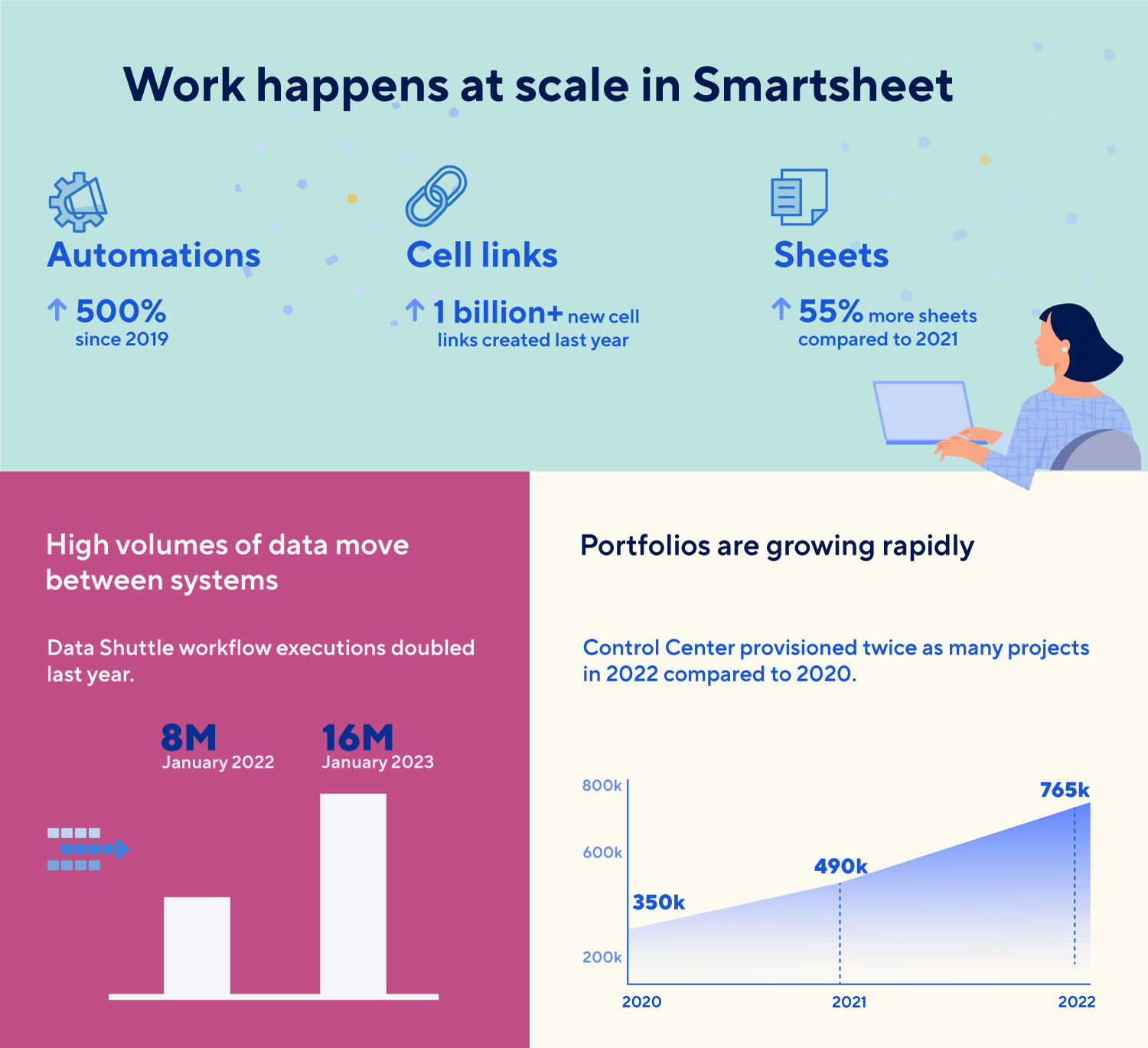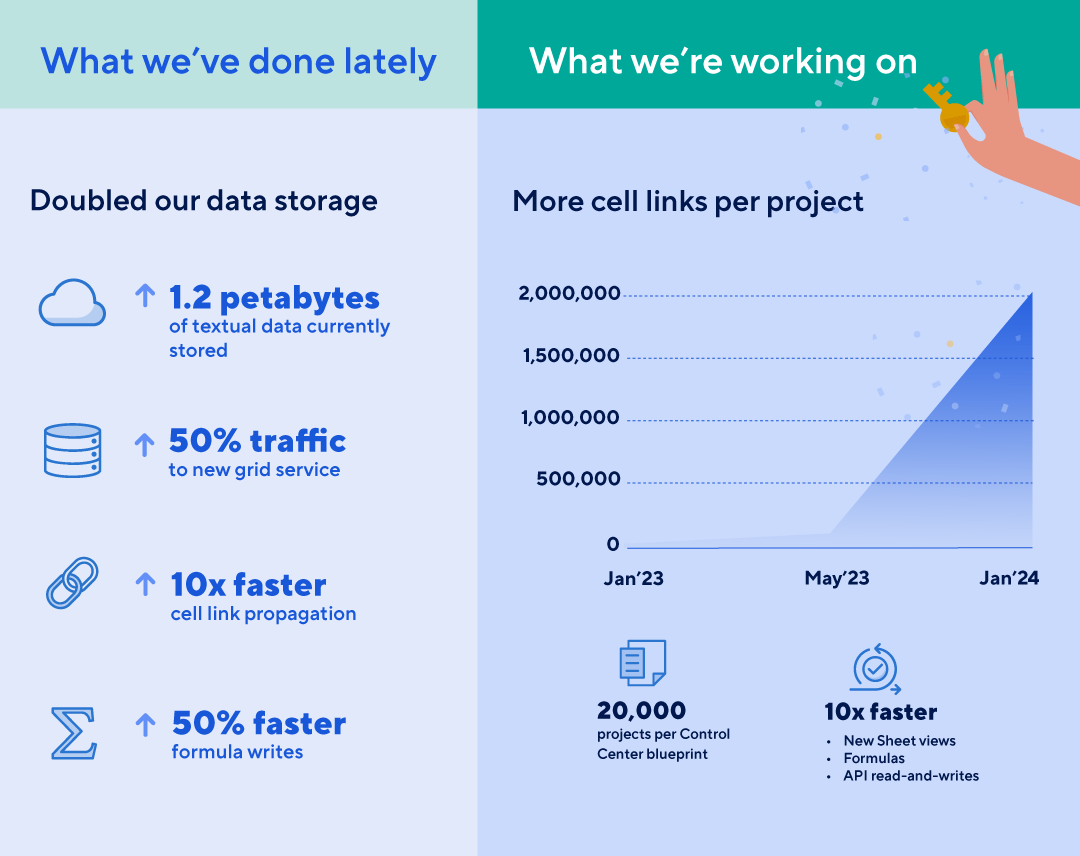Article
Smartsheet continues focus on scale and reliability to help customers grow
As the VP for Platform Services at Smartsheet, Gihan leads our core platform teams, which focus on scaling our sheet infrastructure, administration and authentication space, and our data integration workflow platforms. Throughout his 17-year career, Gihan has worked in multiple startups in this space, from data center automation and virtualization platforms to highly-scalable workflow and messaging platforms. Gihan joined Smartsheet in 2018 as part of the Converse.AI acquisition, where he was a co-founder.
Scaling is a journey that never ends, but at Smartsheet, it’s one of our highest priorities in order to serve our customers as they continue to grow with us.
As we push our customers to think differently about work management, they, in turn, leverage our powerful systems by building large-scale solutions and running workloads more complex than we could have even dreamed of a few years ago.
In our core Smartsheet Platform, we’re tracking tremendous growth.
- Automations have grown 500% since 2019
- 55% more sheets were created last year than the year before (~51 million sheets created last year vs ~33 million sheets created in 2021)
- Over one billion new cell links — linking data across sheets — were created last year
Things get even more complex when we look at the solutions our largest customers use to manage projects at scale. Smartsheet Control Center, the engine which allows enterprises to consistently automate and scale their project portfolio, provisioned 210% more projects in 2022 than in 2020. Here’s a breakdown of provisioned projects by year.
- 2020: ~350 thousand projects
- 2021: ~490 thousand projects
- 2022: ~765 thousand projects
Furthermore, we’ve seen a major increase in data being transferred from other systems to Smartsheet. Data Shuttle is one of our enterprise offerings which allows our customers to transfer large datasets using no-code automated workflows. In January 2022, Data Shuttle ran ~8M workflows importing and exporting customer data. And in January 2023, we executed 16M workflows.
What our customers do in Smartsheet is incredible and often mission critical. For that reason, we consider reliability and scalability the most important features that we can deliver to our customers.
Recent investments in scale
All of the data and information you document within sheets in Smartsheet are held in a system that we call the grid platform. To support this exponential growth, we made the following investments in the grid platform:
- We doubled our data stores so we can effectively hold more customer sheet data, which we call shards. To get the maximum read write throughput, we distribute your data among these shards. Currently we are holding more than 1.2 petabytes of textual data. We are continuously investing in efficient ways to store this increasing volume of data, so you can quickly access the data you need.
- We invested in operational tooling, giving us the ability to quickly move your data between shards when we observe bottlenecks while reading/writing data across the shard farm.
- We built a new data access layer, which we call grid service, and started migrating grid data access traffic, helping us scale our processing capacity on demand. We have already migrated over 50% of our grid traffic into this new service. Currently, all the form submissions, single sheet report loads, and cell link propagation traffic are handled through this new system, reducing latencies. We plan to reach 90% traffic going through grid service by the end of year.
- We built a new cell link management system to reliably propagate cell data between sheets. With the new system, we’re able to increase our overall success rate from 98.5% to 99.995%. To put that into perspective, on the scale of a billion cell links, even a 0.1 error rate has a considerable impact on our customers.
- We reduced our overall cell link propagation latency by 10x for high traffic sheets by introducing an adaptive batching mechanism, meaning you’ll see your real-time information show up faster, with greater efficiency, across sheets.
- With recent changes that we did to our formula engine, we were able to cut the write latencies by ~50% on sheets that heavily use formulas, meaning you can save sheets with many complex formulas that much faster.
What’s next
As previously mentioned, scale and performance is a journey that never ends. We are continuing to focus on how we can push our scale boundaries to most effectively support our customers. Here are the next set of key enhancements we are driving towards:
- With the work above, we increased the default inbound cell links limit from 30,000 to 100,000 per sheet, and we are aiming to achieve two million cell links per sheet by the end of the year, so you can manage more interconnected projects.
- We are building a new set of sheet views — a new and improved Grid and Card view, and the all-new Timeline view — that will be at least 10x faster.
- We are set to grow the number of simultaneous projects from a single blueprint a customer can have in Smartsheet Control Center to up to 20,000 projects.
- We are further investing in our formula engine for 10x faster and more scalable formulas.
- For customer solutions which use our public APIs, we are aiming to provide at least 10x faster sheet read-and-write operations.
We hope this gives you a peek at the work we are doing "under the hood" to make Smartsheet scale and perform for your most complex work programs and processes.
We always want to hear from you and work with you. If you want to talk to our Product and Engineering leadership about these topics, please reach out to your CSM or sales representative.
You can also view the most up-to-the-minute information on service availability, or subscribe to service interruption notifications, at status.smartsheet.com.

